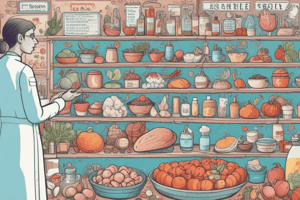Podcast
Questions and Answers
What is food microbiology?
What is food microbiology?
- The study of different types of food.
- The study of microorganisms involved in the spoilage of food, manufacture of food, and transmission of diseases via food. (correct)
- The study of different cuisines from around the world.
Why is food safety important in food microbiology?
Why is food safety important in food microbiology?
- It ensures that food is prepared in a clean environment.
- It helps prevent the transmission of infectious agents. (correct)
- It helps preserve food against microorganisms.
What is the main problem caused by microorganisms in food microbiology?
What is the main problem caused by microorganisms in food microbiology?
- Food spoilage.
- Food preservation.
- Food contamination. (correct)
Which of the following is NOT a common foodborne pathogen?
Which of the following is NOT a common foodborne pathogen?
What is the optimal temperature range for bacterial growth in food?
What is the optimal temperature range for bacterial growth in food?
Which of the following is an example of a food preservation method that relies on reducing water activity?
Which of the following is an example of a food preservation method that relies on reducing water activity?
Flashcards
Food Microbiology Definition
Food Microbiology Definition
The study of microorganisms in food, including spoilage, production, and disease transmission.
Food Safety Importance
Food Safety Importance
Preventing disease transmission through food consumption.
Microorganism Food Problem
Microorganism Food Problem
Food contamination
Uncommon Foodborne Pathogen
Uncommon Foodborne Pathogen
Signup and view all the flashcards
Bacterial Growth Temp Range
Bacterial Growth Temp Range
Signup and view all the flashcards
Water Activity Preservation
Water Activity Preservation
Signup and view all the flashcards
Study Notes
Food Microbiology
- Food microbiology is the study of the microorganisms that inhabit, contaminate, or are used to ferment foods.
Importance of Food Safety
- Food safety is crucial in food microbiology because microorganisms can cause foodborne illnesses, which can lead to severe health consequences, including death.
Microorganisms in Food
- The main problem caused by microorganisms in food microbiology is food spoilage and contamination, leading to foodborne illnesses.
Foodborne Pathogens
- NOT a common foodborne pathogen: ** Viruses ** (bacteria, viruses, parasites, and fungi are common foodborne pathogens, but viruses are not typically associated with foodborne illnesses)
Bacterial Growth in Food
- Optimal temperature range for bacterial growth in food: ** between 20°C and 40°C ** (bacteria grow rapidly within this range)
Food Preservation Methods
- Reducing water activity is an example of a food preservation method that relies on: ** desiccation or drying ** (reducing water activity inhibits microbial growth, and desiccation or drying is one method to achieve this)
Studying That Suits You
Use AI to generate personalized quizzes and flashcards to suit your learning preferences.




